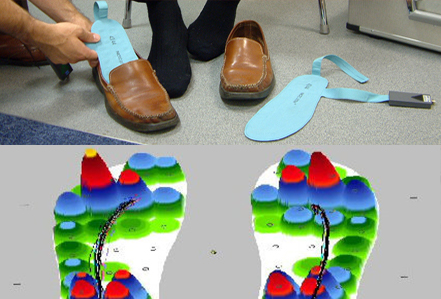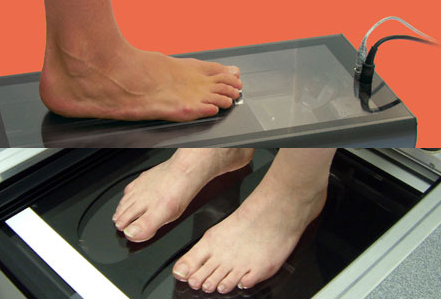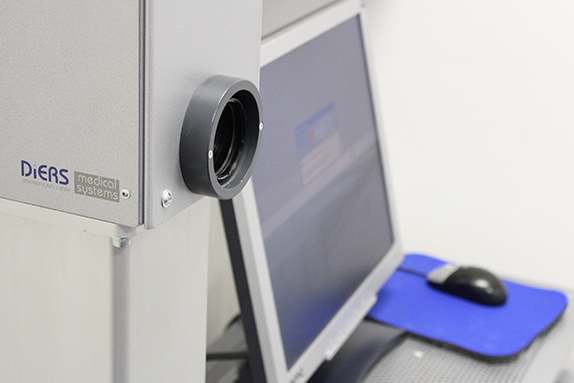The key to an individual’s posture is what is known as proprioception. This is the sense that is used by the body to determine the position of the other related parts of the body. Muscles maintaining posture are involuntary and regulated by the stimulation of the sensory nerve cells called proprioceptors. The proprioceptors constantly send signals to the central nervous system to maintain balance and posture, through all types of daily activities. They are found in various parts of the body; such as the inner ear, palms of the hand or the soles of the feet.
During your consultation, LOC’s clinician will have identified what kind of postural problem you have. Proprioception Therapy will correct the problem by subtly changing the stimulation of the proprioception nerve cells in the soles of your feet.
The proprioception nerve cells are stimulated by specifically designed pads placed under the soles of the feet. The pads are designed to change the tension in the muscle on the soles of the feet, which, in turn, sends signals via the proprioception nerve cells to the cerebellum. The cerebellum then alters muscular tension throughout the body, thus causing a change in posture.

Wearing Proprioceptive insoles will have the following effects:
While wearing the insoles, you should experience an immediate improvement in your back pain and posture. Unlike conventional insoles, the proprioception insoles stimulate your body’s own musculature to improve its alignment and posture, therefore preventing weakness from occurring due to being reliant on support.
Benefits of proprioceptive insoles over conventional insoles:

The assessment and spinal scan are designed to categorise your posture type and highlight any postural asymmetry. With this information, a prescription can be made and the correct proprioceptors for your individual posture type chosen. There are numerous possible combinations and each prescription is tailored to an individual’s requirements, and therefore, genuinely unique.
The proprioceptors are then positioned under the sole of your feet while you stand on a foot scanner. Constant feedback from the scanner throughout the positioning process ensures an optimum result, and you can feel an immediate effect.
The positioning is then accurately captured using the foot scanner and processed by 3D modelling software. The insoles are then manufactured by a computer-controlled milling machine, ensuring that the proprioceptors are positioned exactly on the insole as they were during the assessment.

| Posture/Back Pain Assessment | £270 |
| Posture/Back Pain Review Appointment | £96 |
| First Pair Neuromuscular Proprioceptive Insoles | £230 |
| Repeat Pair Neuromuscular Proprioceptive Insoles | £175 |
| Diers 3D Posture Spinal Scan | £100 |
| Reviews (6 week review) | FREE |
| Additional Reviews | £96 |
We have the following facilities and amenities at our Kingston Upon Thames location:
We also have the Gait Laboratory for orthotics patients and Onsite Manufacturing for speedy turnarounds and adjustments whilst you wait.
An insole is a contoured orthotic device which alters the characteristics and biomechanics of the foot and ankle area. Biomechanics are concerned with mechanical laws and how they affect the living body, especially the musculoskeletal system.
They are removable devices, often made from plastic, that are designed to fit inside a shoe to provide additional support for your feet. As well as offering shock absorption, an insole can help distribute the weight of your body more effectively across the foot and can be made bespoke to cover a range of biomechanical conditions.
If you have symptoms in your feet, ankles, hips or your lower back that are intermittent or were not there to start with in early life, and have started to cause you pain over a period of time, bespoke orthotic insoles could be an excellent option.
If you have already tried rest, icing, compression and elevation and your feet have not recovered, we recommend a biomechanical assessment to consider the possibility of insoles. They are a non-invasive approach to treatment and in many cases, are a great option for symptoms that are not severe enough to warrant surgical intervention. Alternatively, they can be considered as an option prior to surgery.
We will send patients away when an insole is not appropriate, if a patient is suffering with iliotibial band syndrome for example, the problem can be helped with physiotherapy and a stretching programme. That’s what our biomechanical assessment is all about; determining whether there would be any benefit from altering the alignment of your feet.
Clothing worn is dependent on which clinic you are attending. You will be sent a letter detailing what clothing to wear along with all other details prior to any appointment at the clinic.

Join The London Orthotic Consultancy in celebrating Cerebral Palsy Awareness Day on March 25th. Learn just how important expert orthotic care is in enhancing mobility, independence, and quality of life for children and adults with cerebral palsy.

Introducing the Agilik™ smart orthosis, a cutting-edge, powered knee orthotic now available in the UK through the London Orthotic Consultancy. Unlike traditional KAFOs or heavy exoskeletons, the Agilik™ provides dynamic knee assistance and offers real-time support, reducing fatigue and improving posture. This pioneering, modern technology can help children and adults with lower limb weakness walk more efficiently and naturally. We are honoured to be selected as the exclusive paediatric specialist centre in the UK for the Agilik™ device.

When Sophie noticed her baby Max had a persistent flat spot on his head, she was told it would resolve naturally—but it didn’t. Seeking a second opinion led her to the London Orthotic Consultancy, where Max was diagnosed with severe plagiocephaly.

A little more than four years after the LOCband Lite's launch, we're proud to have successfully treated our 250th helmet therapy patient at our Romford clinic using our cutting-edge 3D-printed cranial band. After five months of treatment, her final scan showed that her asymmetry had decreased from 12 mm to 3 mm.

Sky News published an article this month quoting scientists at Southmead Hospital who claimed there was a lack of research into flat head syndrome and its treatment with cranial remoulding (helmet) therapy. This is our response.

With our non-surgical treatment plan, Alex achieved 100% chest correction in just two years. His treatment involved a combination of dynamic chest compressor and vacuum bell therapy treatment to address his pectus excavatum and rib flaring.

Learn how a custom carbon fibre AFO helped Gill regain mobility and comfort despite complex challenges from shin bone (tibia) removal. We created a truly tailored orthotic solution made from pre-preg carbon fibre at our Cambridge clinic.

Discover how bespoke orthotics and the OSKAR program with Elaine Owen transformed Archie’s life with cerebral palsy quadriplegia, helping him avoid a wheelchair and achieve greater mobility.